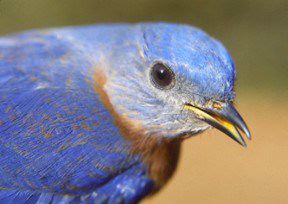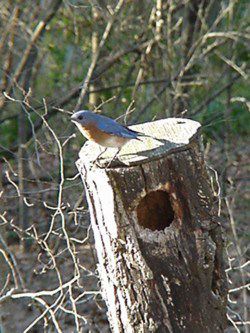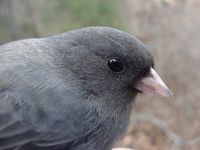 HOME: www.hiltonpond.org |
|
||
|
|
|||
|
|
|||
|
|
|||
|
|
|||
|
|
|||
|
THIS WEEK at HILTON POND |
 All winter, what appear to be established pairs of Eastern Bluebirds (Sialia sialis) have been hanging around together at Hilton Pond Center, periodically investigating cavities in trees and artificial nestboxes. Most of the birds that make up these pairs are banded, having been captured locally in a previous year. A few were netted as adults, but many were banded as nestlings--perhaps from the very nestboxes they now explore. Several times since Christmas we've also seen flocks of 10-15 bluebirds lined up on utility wires that border fields near Hilton Pond Center. A quick look at these birds through a spotting scope typically reveals they aren't banded. We suspect these bluebirds were not produced locally and that they may even be from states much further north. Eastern Bluebirds (Sialia sialis) are year-round residents here in the Carolina Piedmont, just as they are further south. The species is somewhat susceptible to cold, however, so bluebirds from Virginia northward may migrate to our region in fall. As spring arrives, the migrants return to northern climes and get down to the business of trying to find a mate and a place to nest. Resident birds that don't migrate can really get a head start on breeding each year. Not only do they not lose time to migration, but they can already have prospective mates and nest sites selected well in advance of the breeding season.
We recommend that new bluebird boxes go up not later than the third week in February; Valentine's Day is an easily remembered target date. We also suggest that established nestboxes be cleaned thoroughly at the end of the breeding season and left up all winter as potential roosting sites for chickadees, nuthatches, titmice, wrens, and--of course--bluebirds. Roost boxes should be cleaned again by Valentine's Day, just in case winter visitors left behind a few too many calling cards.
If you lack the time or tools to make your own, you may wish to purchase a commercially available bluebird nestbox from Duncraft, an established manufacturer and distributor of bird products. If you click on their logo below and purchase products online, 10% of the sale goes to support research and education at Hilton Pond Center. |
|
NOTE: On Saturday, 10 March 2001, there will be a preliminary meeting in York SC for anyone interested in starting a South Carolina Bluebird Society, to be affiliated with the North American Bluebird Society. If you would like to attend this meeting, or for more information, contact BLUEBIRD for details and directions. Additional meetings will be held later in the spring. |
 Each year, as nesting time gets ever closer, courtship behavior intensifies, and male bluebirds spend their days poking heads into potential nest holes and singing to females (left). Such behavior hasn't occurred yet this year here at Hilton Pond Center; most years we don't usually observe it until around the middle of March. That's good news, becuse it means there's still time to make a few new nestboxes and get them hung for 2001--no matter where you live.
Each year, as nesting time gets ever closer, courtship behavior intensifies, and male bluebirds spend their days poking heads into potential nest holes and singing to females (left). Such behavior hasn't occurred yet this year here at Hilton Pond Center; most years we don't usually observe it until around the middle of March. That's good news, becuse it means there's still time to make a few new nestboxes and get them hung for 2001--no matter where you live. There are about as many different designs for bluebird nestboxes as there are bluebird fanciers, but the most important aspect is that the entry hole be exactly 1.5" in diameter. Any larger and it welcomes use by European Starlings, an aggressive and invasive species that frequently displaces nesting bluebirds. In addition, a "predator plate"--a block of wood about 2" thick nailed to the front of the box (right)--will deepen the entry hole and make bluebird nestlings less accessible to cats and raccoons. Hilton Pond Center's Web site includes plans for one type of easily constructed and easily maintained box at
There are about as many different designs for bluebird nestboxes as there are bluebird fanciers, but the most important aspect is that the entry hole be exactly 1.5" in diameter. Any larger and it welcomes use by European Starlings, an aggressive and invasive species that frequently displaces nesting bluebirds. In addition, a "predator plate"--a block of wood about 2" thick nailed to the front of the box (right)--will deepen the entry hole and make bluebird nestlings less accessible to cats and raccoons. Hilton Pond Center's Web site includes plans for one type of easily constructed and easily maintained box at 



